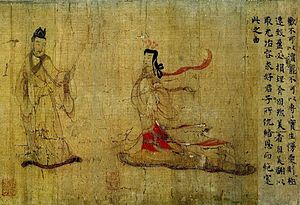
Back رفض اجتماعي Arabic Социално отхвърляне Bulgarian সামাজিক প্রত্যাখ্যান Bengali/Bangla Rebuig social Catalan Social udstødelse Danish Ostrazismus (Psychologie) German Κοινωνική απόρριψη Greek Rechazo social Spanish طرد اجتماعی Persian Sosiaalinen hylkäys Finnish

| Part of a series on |
| Emotions |
|---|
  |
Social rejection occurs when an individual is deliberately excluded from a social relationship or social interaction. The topic includes interpersonal rejection (or peer rejection), romantic rejection, and familial estrangement. A person can be rejected or shunned by individuals or an entire group of people. Furthermore, rejection can be either active by bullying, teasing, or ridiculing, or passive by ignoring a person, or giving the "silent treatment". The experience of being rejected is subjective for the recipient, and it can be perceived when it is not actually present. The word "ostracism" is also commonly used to denote a process of social exclusion (in Ancient Greece, ostracism was a form of temporary banishment following a people's vote).[2]
Although humans are social beings, some level of rejection is an inevitable part of life. Nevertheless, rejection can become a problem when it is prolonged or consistent, when the relationship is important, or when the individual is highly sensitive to rejection. Rejection by an entire group of people can have especially negative effects, particularly when it results in social isolation.[3]
The experience of rejection can lead to a number of adverse psychological consequences such as loneliness, low self-esteem, aggression, and depression.[4] It can also lead to feelings of insecurity and a heightened sensitivity to future rejection.[5]
- ^ McCausland, Shane (2003), First Masterpiece of Chinese Painting: The Admonitions Scroll, British Museum Press, p. 75, ISBN 978-0-7141-2417-9
- ^ "ostracize". Dictionary.com. Archived from the original on 22 October 2021.
- ^ Williams, Kipling D.; Joseph P. Forgas; William von Hippel (2005). The Social Outcast: Ostracism, Social Exclusion, Rejection, and Bullying. Psychology Press. p. 366 pages. ISBN 978-1-84169-424-5.
- ^ McDougall, P., Hymel, S., Vaillancourt, T., & Mercer, L. (2001). The consequences of childhood rejection. In M. R. Leary (Ed.), Interpersonal rejection. (pp. 213–247). New York, NY: Oxford University Press.
- ^ Richman, Laura Smart; Leary, Mark R. (April 2009). "Reactions to Discrimination, Stigmatization, Ostracism, and Other Forms of Interpersonal Rejection". Psychological Review. 116 (2): 365–383. doi:10.1037/a0015250. hdl:10161/11810. ISSN 0033-295X. PMC 2763620. PMID 19348546.
